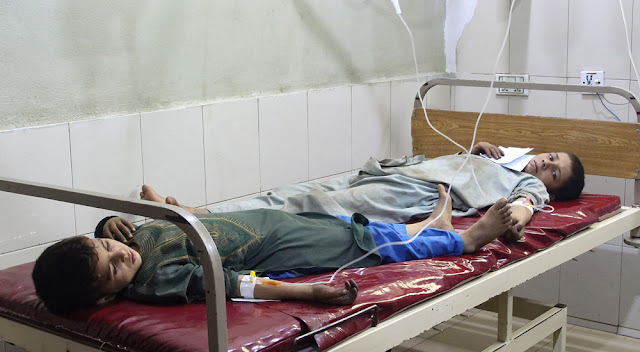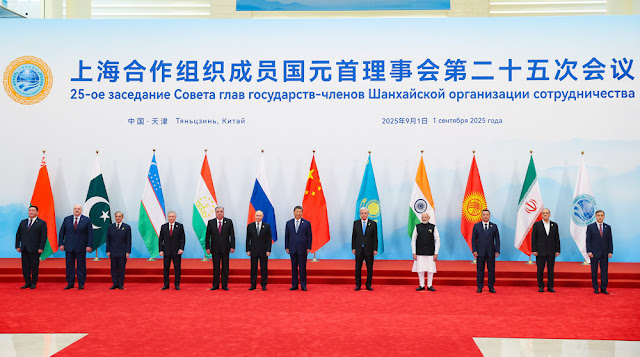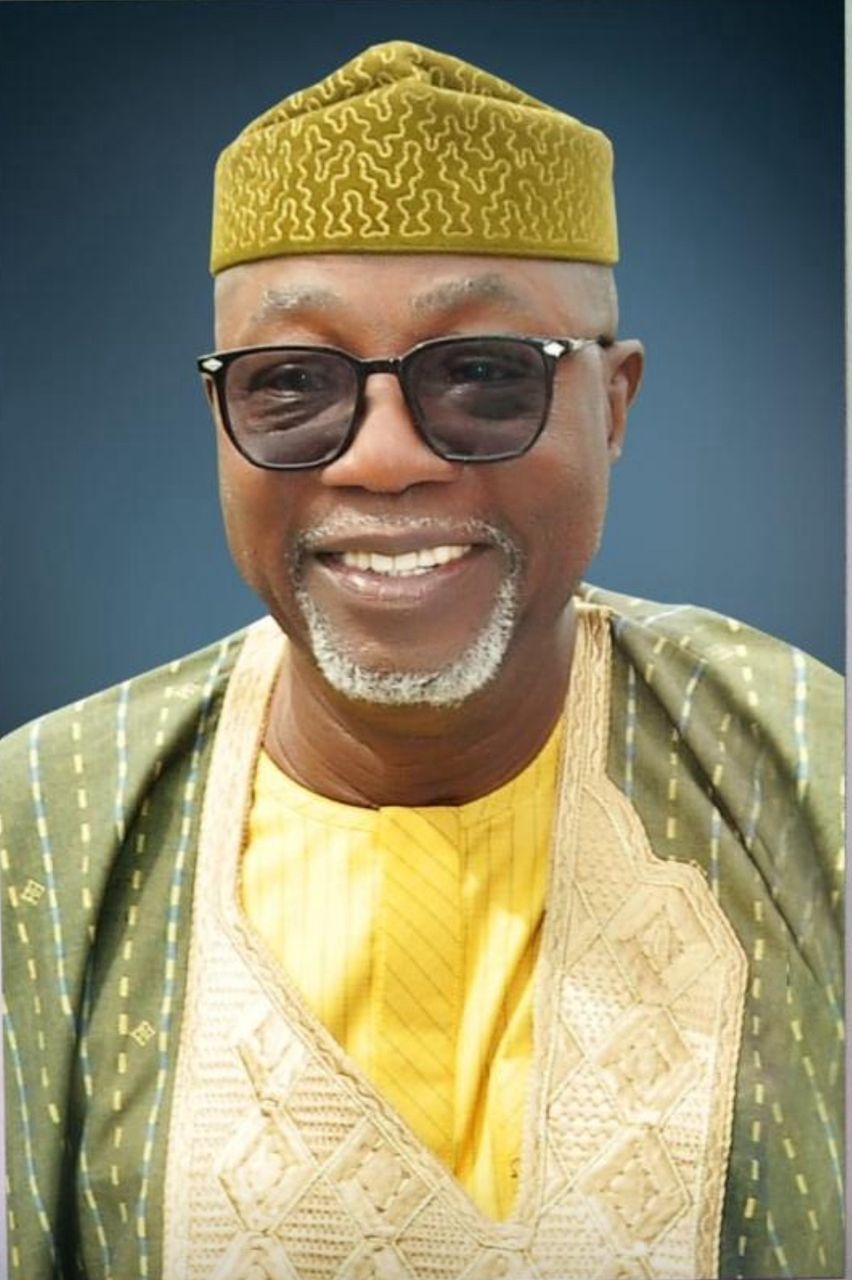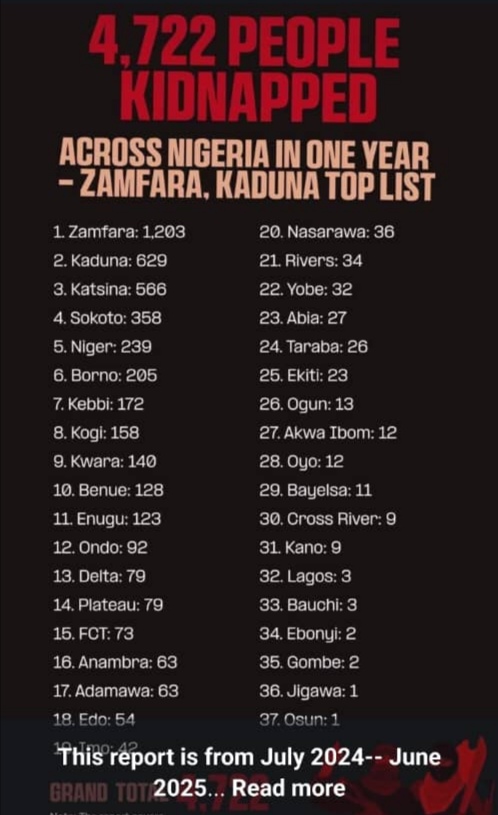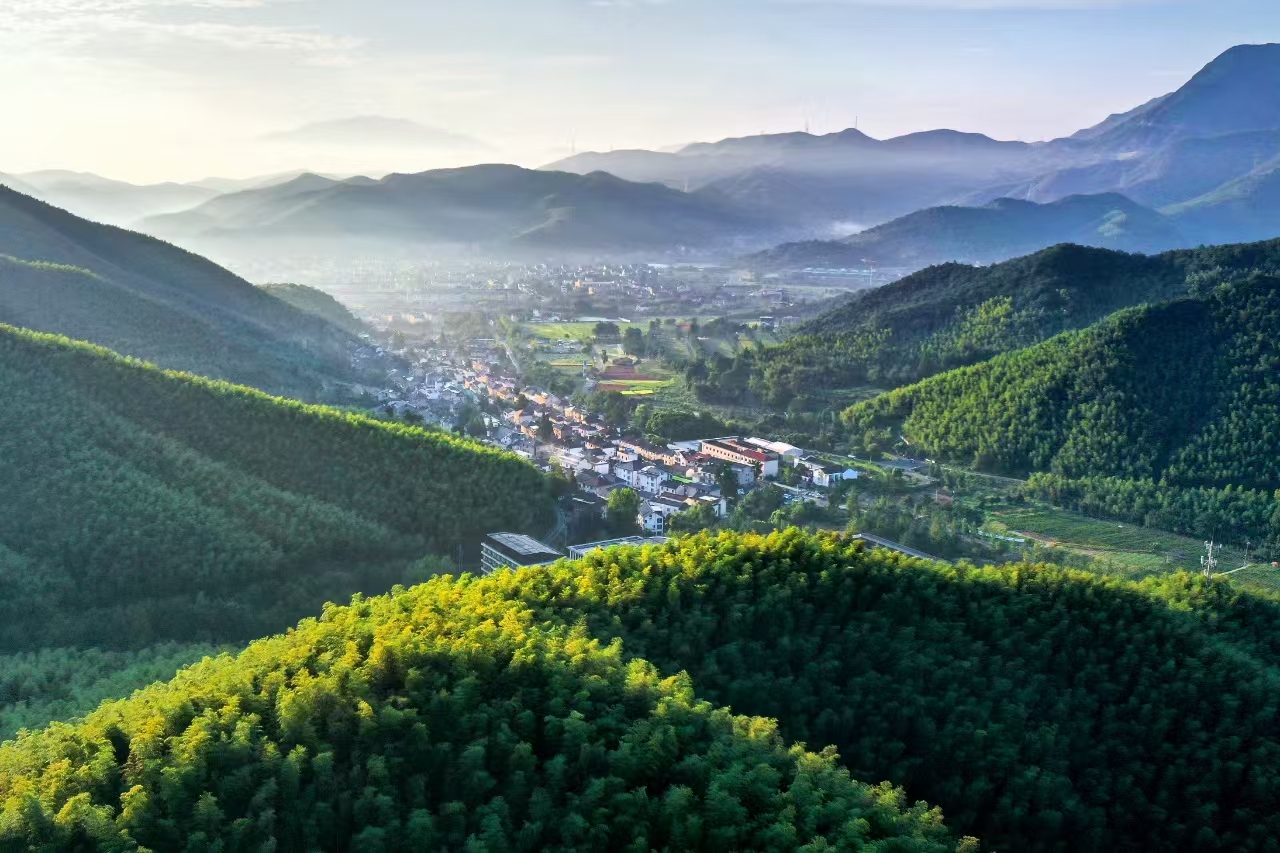On September 1, 2025, a powerful 6.0-magnitude earthquake struck eastern Afghanistan, leaving a trail of destruction and loss that reverberated across the region. The quake, centered near Jalalabad in Kunar province, claimed the lives of at least 800 people and injured over 2,500 others, according to Afghan authorities. In response, Iranian President Masoud Pezeshkian, alongside Foreign Minister Abbas Araghchi and Foreign Ministry Spokesman Esmaeil Baghaei, extended heartfelt condolences to Afghanistan, expressing Iran’s readiness to provide humanitarian aid to the quake-stricken nation. This gesture underscores the deep ties between Iran and Afghanistan, highlighting Tehran’s commitment to supporting its neighbor during a time of crisis and reinforcing the importance of regional solidarity in addressing humanitarian disasters.
Injured Afghan children receive treatment at a hospital following a 6-magnitude earthquake in eastern Afghanistan’s Jalalabad on September 1, 2025. (Photo by AFP)
The earthquake, one of the deadliest in Afghanistan’s recent history, has drawn global attention to the country’s ongoing challenges, from natural disasters to political instability. Iran’s swift response, rooted in a history of neighborly cooperation, offers a beacon of hope amid the tragedy. This article explores the details of the earthquake, Iran’s humanitarian outreach, the broader context of Iran-Afghanistan relations, and the implications for regional stability and disaster response.
The Earthquake: A Catastrophe in Kunar and Beyond
The earthquake struck late on Sunday, August 31, 2025, at approximately midnight local time, with its epicenter located in a mountainous area near Jalalabad, close to Afghanistan’s border with Pakistan. According to the German Research Center for Geosciences (GFZ), the quake occurred at a shallow depth of 10 kilometers (6.2 miles), amplifying its destructive impact. The province of Kunar, known for its rugged terrain and remote villages, bore the brunt of the disaster, with entire communities reduced to rubble. Zabihullah Mujahid, the Taliban’s chief spokesman, reported that 800 people were killed and 2,500 injured in Kunar alone, while an additional 12 deaths and 255 injuries were recorded in neighboring Nangarhar province.
The devastation was immediate and profound. Homes, schools, and infrastructure collapsed, trapping residents under debris and overwhelming local emergency response capabilities. Images from the scene, shared by international media, depicted injured children receiving treatment in makeshift hospitals and local residents assisting Taliban soldiers in rescue efforts. Helicopters were deployed to transport the wounded to medical facilities, but the scale of the disaster strained Afghanistan’s already fragile healthcare system. The quake’s timing, in the dead of night, likely exacerbated the chaos, as many families were caught unprepared.
Afghanistan’s vulnerability to natural disasters is well-documented. The country’s mountainous geography and tectonic activity make it prone to earthquakes, while decades of conflict, poverty, and underdevelopment have left its infrastructure ill-equipped to handle such crises. The 2022 earthquake in Paktika province, which killed over 1,000 people, serves as a grim reminder of the country’s recurring struggles with seismic events. The 2025 Kunar earthquake, while slightly less deadly, has compounded Afghanistan’s humanitarian challenges, coming at a time when the nation is still grappling with the effects of war, economic sanctions, and political isolation under Taliban rule.
Iran’s Response: Condolences and Commitment to Aid
In the wake of the disaster, Iranian President Masoud Pezeshkian issued a formal message of condolence on Monday, September 1, 2025, expressing solidarity with the Afghan people and government. “The Islamic Republic of Iran stands ready to cooperate with Afghanistan to provide humanitarian relief aid to our neighboring country,” he stated, emphasizing Tehran’s commitment to supporting Afghanistan’s recovery efforts. Pezeshkian’s message highlighted the shared history and cultural ties between the two nations, framing Iran’s response as a moral and neighborly obligation.
Foreign Minister Abbas Araghchi echoed the president’s sentiments, announcing Iran’s preparedness to dispatch relief and medical assistance to the quake-affected areas. In a statement, Araghchi expressed hope that regional and international cooperation would alleviate the suffering of the victims, underscoring the need for a collective response to the crisis. Similarly, Foreign Ministry Spokesman Esmaeil Baghaei voiced Iran’s readiness to assist with the treatment of the injured, reinforcing Tehran’s proactive stance in offering practical support. These statements reflect Iran’s broader foreign policy of fostering regional stability through humanitarian engagement, particularly with its neighbors.
Iran’s offer of aid is not an isolated gesture but part of a consistent pattern of support for Afghanistan during times of crisis. In recent years, Iran has provided humanitarian assistance following natural disasters, including earthquakes and floods, as well as support for Afghan refugees fleeing conflict. The dispatch of a fourth consignment of humanitarian aid to Afghanistan in response to earlier earthquakes demonstrates Tehran’s ongoing commitment to its neighbor’s welfare. This latest pledge of assistance, while still in the planning stages, is expected to include medical supplies, food, shelter materials, and possibly personnel to aid in rescue and recovery efforts.
Iran-Afghanistan Relations: A Complex Bond
The relationship between Iran and Afghanistan is deeply rooted in history, culture, and geography. Sharing a 900-kilometer border, the two nations have maintained close ties despite periods of tension. Iran hosts one of the largest Afghan refugee populations in the world, with millions having fled to Iran during decades of conflict, from the Soviet invasion in the 1980s to the U.S.-led occupation and the Taliban’s return to power in 2021. These refugees, many of whom are ethnic Hazaras with cultural and linguistic ties to Iran, have strengthened the human connection between the two countries.
Politically, Iran’s relationship with the Taliban-led government has been pragmatic yet cautious. Since the Taliban’s takeover in August 2021, Iran has engaged with the interim government on issues such as border security, trade, and water rights, particularly concerning the Helmand River, which has been a source of occasional disputes. Tehran has advocated for an inclusive Afghan government that represents all ethnic and religious groups, reflecting its concern for the Shiite Hazara minority, who have faced persecution under previous Taliban regimes. Despite these challenges, Iran has maintained diplomatic channels with the Taliban, hosting Afghan officials and participating in regional dialogues to stabilize Afghanistan.
The earthquake response offers an opportunity to strengthen these ties. By providing humanitarian aid, Iran positions itself as a reliable partner, contrasting with the Western sanctions and isolation that have hindered Afghanistan’s recovery. This gesture also aligns with Iran’s broader foreign policy of countering U.S. influence in the region while fostering solidarity with neighboring states. President Pezeshkian’s emphasis on regional cooperation, as seen in his address to the Shanghai Cooperation Organization (SCO) summit in Tianjin on September 1, 2025, underscores this strategy, advocating for closer financial and political ties to reduce reliance on Western systems.
The Humanitarian Crisis: Challenges and Needs
The Kunar earthquake has exacerbated Afghanistan’s already dire humanitarian situation. The country faces multiple overlapping crises, including poverty, food insecurity, and a healthcare system crippled by years of conflict and international sanctions. The UN estimates that over 24 million Afghans—more than half the population—require humanitarian assistance in 2025, with women and children particularly vulnerable. The earthquake’s impact on Kunar and Nangarhar, regions with limited infrastructure, has intensified these challenges, as damaged roads and hospitals hinder aid delivery and rescue operations.
The immediate needs in the affected areas include medical care for the injured, shelter for displaced families, and food and clean water to prevent disease outbreaks. The shallow depth of the earthquake increased its destructive power, leveling mud-brick homes common in rural Afghanistan and leaving thousands homeless. Local residents and Taliban soldiers have been working tirelessly to clear debris and rescue survivors, but the scale of the disaster requires international support. Helicopters have been deployed to transport the wounded, but the lack of advanced medical facilities in the region has heightened the urgency of external aid.
Iran’s offer of medical and relief assistance is particularly significant given Afghanistan’s strained relations with Western donors. Since the Taliban’s return to power, international aid has plummeted due to sanctions and restrictions on engaging with the Taliban-led government. Iran, unbound by these constraints, is well-positioned to fill this gap, leveraging its proximity and experience in disaster response. Previous Iranian aid efforts, such as those following floods in northern Afghanistan, have included food, tents, and medical teams, providing a model for the current response.
Profiles of Key Figures: Leadership in Crisis
President Masoud Pezeshkian: Elected in 2024, President Pezeshkian has positioned himself as a reformist leader committed to diplomacy and regional cooperation. His response to the Afghan earthquake reflects his broader vision of strengthening ties with neighbors and countering Western sanctions through multilateral frameworks like the SCO. Pezeshkian’s condolence message and pledge of aid underscore his emphasis on humanitarian diplomacy, a hallmark of his administration’s early months. His address at the SCO summit, where he proposed financial mechanisms to reduce reliance on the U.S. dollar, further illustrates his strategic approach to regional leadership.
Foreign Minister Abbas Araghchi: A seasoned diplomat, Araghchi has played a key role in shaping Iran’s foreign policy, including its response to the Afghan crisis. His experience as a negotiator in the 2015 Iran nuclear deal (JCPOA) and his recent criticism of the Non-Proliferation Treaty (NPT) highlight his assertive stance on Iran’s sovereignty and regional influence. Araghchi’s call for regional cooperation in aiding Afghanistan reflects his belief in collective action to address shared challenges, particularly in the face of Western isolation.
Esmaeil Baghaei: As Foreign Ministry Spokesman, Baghaei has been a vocal advocate for Iran’s humanitarian efforts. His statement on the earthquake emphasized practical support, such as medical assistance for the injured, aligning with Iran’s broader policy of aiding neighbors in distress. Baghaei’s role in communicating Iran’s position to the international community is crucial, especially given the global attention on Afghanistan’s crisis.
Zabihullah Mujahid: The Taliban’s chief spokesman, Mujahid provided the official death toll and injury figures, highlighting the scale of the disaster. His role as a key communicator for the Taliban government underscores the challenges of coordinating international aid under a regime that remains unrecognized by most countries. Mujahid’s press conference in Kabul was a rare moment of transparency, signaling the Taliban’s willingness to accept foreign assistance to address the crisis.
Geopolitical Implications: Regional Solidarity and Global Dynamics
Iran’s response to the Afghan earthquake carries significant geopolitical weight. By offering aid, Tehran reinforces its role as a regional leader, particularly within the SCO and among Muslim-majority nations. The gesture contrasts sharply with the Western approach, which has largely isolated Afghanistan since 2021. Sanctions imposed by the U.S. and its allies have frozen Afghan assets and restricted aid flows, exacerbating the country’s humanitarian crisis. Iran’s willingness to step in highlights its strategic positioning as an alternative to Western influence, a theme Pezeshkian emphasized at the SCO summit.
The earthquake response also offers Iran an opportunity to strengthen ties with the Taliban government, despite past tensions over issues like water rights and refugee treatment. By framing its aid as a neighborly act, Iran seeks to build goodwill and foster stability along its eastern border. This is particularly important given the security threats posed by instability in Afghanistan, including the potential for cross-border militancy and refugee flows.
Globally, Iran’s actions draw attention to the broader issue of humanitarian access in conflict zones. The international community’s reluctance to engage with the Taliban has left Afghanistan dependent on regional actors like Iran, Pakistan, and China for support. Iran’s call for regional cooperation, echoed by Araghchi, suggests a model for addressing crises that bypasses Western sanctions, potentially reshaping aid dynamics in the region.
Critical Analysis: Beyond the Headlines
While Iran’s offer of aid is a commendable step, a critical examination reveals complexities in its implementation and broader implications. First, the logistics of delivering aid to Afghanistan are daunting. Kunar’s remote terrain and damaged infrastructure pose significant challenges, requiring coordination between Iranian and Afghan authorities. The Taliban’s limited administrative capacity and lack of international recognition may further complicate aid distribution, raising questions about transparency and effectiveness.
Second, Iran’s humanitarian gesture must be viewed in the context of its domestic and regional priorities. Tehran faces its own economic challenges due to U.S. sanctions, which could limit the scale of its aid. Additionally, Iran’s support for Afghanistan aligns with its strategic goal of countering U.S. influence, suggesting that the offer is as much a diplomatic maneuver as a humanitarian one. This dual purpose does not diminish the aid’s value but highlights the interplay of politics and compassion in Iran’s foreign policy.
Finally, the international community’s response to the earthquake remains uncertain. While Iran has taken a proactive stance, Western nations have been slow to pledge support, likely due to political sensitivities surrounding the Taliban. This hesitation risks leaving Afghanistan reliant on a handful of regional actors, potentially deepening its isolation. Iran’s call for joint cooperation, as articulated by Araghchi, challenges the global community to rethink its approach to humanitarian crises in politically contentious contexts.
The Broader Context: Afghanistan’s Ongoing Struggles
The Kunar earthquake is not an isolated event but part of a broader pattern of crises afflicting Afghanistan. Since the Taliban’s return to power, the country has faced economic collapse, food insecurity, and a series of natural disasters, including earthquakes and floods. The withdrawal of U.S. and NATO forces in 2021, coupled with the freezing of Afghan assets, has left the country in a precarious state. The UN’s 2025 humanitarian appeal for Afghanistan, seeking $3.6 billion, remains underfunded, reflecting the global community’s reluctance to engage with the Taliban-led government.
The earthquake’s toll adds to these challenges, particularly for women and children, who are disproportionately affected by disasters. The Taliban’s restrictions on women’s rights, including access to education and employment, have further compounded vulnerabilities, making recovery efforts more complex. Iran’s aid offer, while focused on immediate relief, could also pave the way for broader discussions on supporting Afghanistan’s long-term resilience, including infrastructure development and healthcare capacity.
Conclusion: A Call for Solidarity
Iran’s response to the September 1, 2025, earthquake in Afghanistan is a testament to the power of regional solidarity in times of crisis. President Pezeshkian’s condolences and pledge of aid, supported by Foreign Minister Araghchi and Spokesman Baghaei, reflect Iran’s commitment to its neighbor and its broader vision of cooperative diplomacy. The gesture not only addresses the immediate needs of quake-affected communities but also strengthens Iran-Afghanistan ties, offering a counterpoint to Western isolationism.
As Afghanistan grapples with the aftermath of the disaster, the international community faces a moral imperative to act. Iran’s leadership in providing aid sets an example, but the scale of the crisis demands a collective response. The Kunar earthquake is a stark reminder of Afghanistan’s fragility and the need for sustained global engagement to address its humanitarian and developmental challenges. For now, Iran’s outstretched hand offers hope, but the path to recovery will require unity, compassion, and a commitment to rebuilding a nation scarred by both nature and history.


